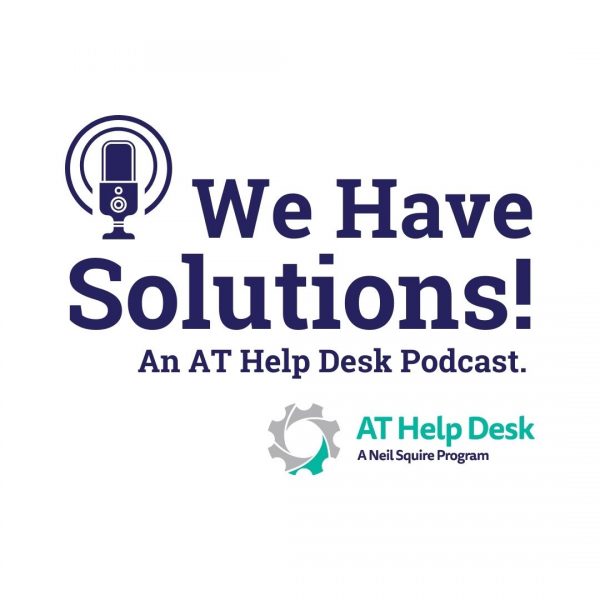New Hearing Aids Help Steve Help His Clients

Steve is a community support worker who works with children with behavioural issues in 100 Mile House.
“My hearing ability is severely compromised,” he shares. “During our counseling sessions, it is imperative that I am able to listen and hear all of the sensitive disclosures and other thoughts that they may want to share. Building a successful rapport is key to our trust based working relationship.”
Kim Builds Her Self-Employment Opportunities With the Help of WorkBC Assistive Technology Services

Kim is a self-employed healthcare community support worker in Kelowna. Her duties include assisting her clients in daily tasks, supporting their emotional wellbeing, attending doctors appointments with clients, and providing support on recreational outings.
She was born with hearing loss in both ears.
“This has affected my ability in reaching out to potential new clients and businesses,” she explains.
Here’s to 39 Years!

Today Neil Squire is celebrating 39 years!
Since 1984, we have worked to empower nearly 75,000 Canadians with disabilities.
We’re so proud of our participants, staff, volunteers, and supporters, and of all of the work we’ve done together.
Thank you for being part of our journey.
Language Therapy 4-in-1

Losing your ability to speak due to aphasia, stroke, or other brain injury can feel like being a prisoner in your own mind, especially when you’ve spent your entire pre-injury life with normal speech and language skills. Thankfully there are apps and other resources available to individuals suffering from speech and language-based injuries/disabilities.
New Hearing Aids Help Carolina Land the “Perfect Job”

With the help of new hearing aids received through WorkBC Assistive Technology Services, Carolina says she has found her “perfect job.”
Carolina is hard of hearing.
“[It] does affect you with your confidence,” she shares.
Microsoft Accessibility Page

Staying on top of accessibility updates, features, news, and resources is no easy task, even here at the AT Help Desk where we do our absolute best to cover everything we can, there’s just so much accessible content and information out there that it’s impossible to keep track of absolutely everything related to accessibility. Thankfully, most companies who deal with accessible devices do a great job of providing information and resources related to those products. That is especially true for Apple’s excellent accessibility page, which we have discussed in previous e-bulletins.
Today however, we are going to look at Apple’s chief competitor Microsoft, and we are going to see how their newly redesigned accessibility page stacks up against the competition. And with Windows products and Microsoft 365 being so widely used within the New Brunswick school system, this information will be useful to just about any parent, teacher, or student with accessibility needs.
Hearing Aids “Help Me to Communicate With My Clients”

Iryna is a self-employed residential cleaner.
“My hearing is not good,” she shares. “It impacts my communication with clients.”
She was referred to WorkBC Assistive Technology Services by her audiologist at the Wavefront Centre for Communication Accessibility. WorkBC Assistive Technology Services provided her with funding for new hearing aids.
MentalUp: A Learning and Gaming Platform for Kids

We all like to have choices in life, and kids are no different. In 2023, there’s certainly no shortage of games and gaming platforms to choose from, and apps like Roblox see millions of users and new games added every single day. So why can’t we apply the same approach the educational content? Wouldn’t it be great for students to choose from as wide a range of educational content as possible? The developers of the app that we are looking at today clearly thought so!
MentalUp is an app-based gaming and learning platform which features thousands of games, hundreds of fitness exercises, tests, and much more. When you first turn on the app, you’ll be prompted to enter some information regarding your child’s age and learning needs. Once you’ve completed the initial set up, then you’ll find yourself in the MentalUp “galaxy” where you can choose from a variety of activities. To choose between categories of activities, users navigate to different “planets”.
We Have Solutions! – Episode 15: CSUN and AT Training with Erin LeBlanc

Today we are joined once again by digital literacy and assistive technology trainer Erin LeBlanc. We discussed her experiences at the CSUN assistive technology conference, the steps required to become accredited in AT, her experiences with her own CSUN course, and much more. If you’ve ever thought about pursuing a degree or certificate in AT, then you won’t want to miss this one.
“I Was Able to Get My Confidence Back,” John’s New Hearing Aids Make a World of Difference

John is a veterinary technician working in Burnaby. His duties include working with pet owners to determine the animal’s medical history, as well as assisting the veterinarian during procedures like surgery. His job requires him to talk a lot on the phone.
He began having hearing difficulties in 2021, culminating with tinnitus in September of that year.
“[It] resulted in [me] losing 80% of my hearing. It was very challenging for me, it impacted me in a lot of ways I would have never imagined. Mentally, I felt left out,” he explains. “In terms of job searching, it was hard to find an employer who will understand my condition. (I’m glad I found a very supportive and caring team). Hearing plays a vital role in my daily life.”



